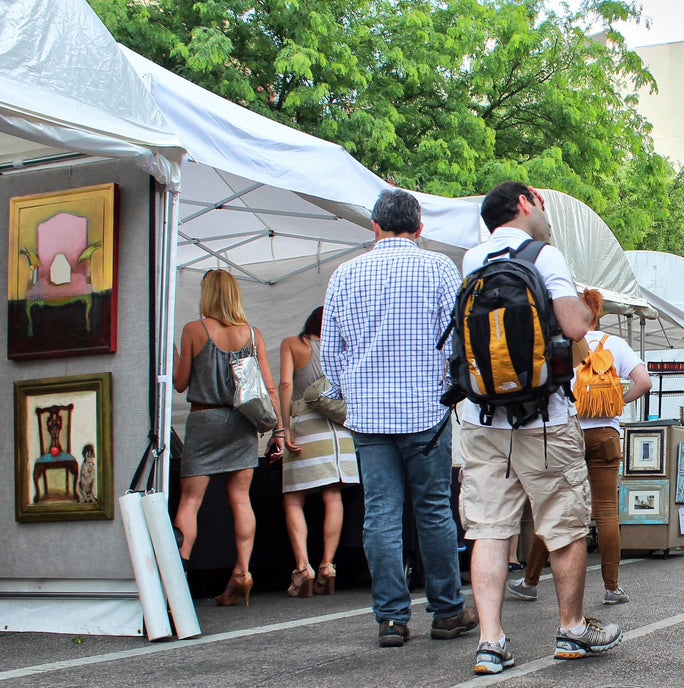How Art Fosters Healing in Hospitals



“Variety of form and brilliancy of colour in the objects presented to patients are actual means of recovery.”
--Florence Nightingale
Hospitals, doctor’s offices, medical waiting rooms -- there isn’t a person among us who hasn’t taken up temporary residency, perhaps somewhat anxiously, within these spaces. Whether we are scheduled for a routine appointment, visiting a loved one in the hospital, or we ourselves are the admitted patient, medical appointments and health treatments can be stressful situations. As we consider how art can be incorporated for healing, we can’t overlook some of the most common sites in which people receive care for their ailments, such as medical facilities and hospitals.
A 2009 survey indicated that 40% of medical facilities have made deliberate efforts to include thoughtful art for its healing qualities as part of their decor, and the trend has only increased in the last decade. There is ample evidence that art in the medical setting can go a long way toward distracting a patient from pain and discomfort and improving their outlook, as well as the general mood of visitors.
(Please note that the following is not intended to be a substitute for professional medical advice, diagnosis, or treatment, and does not constitute medical or other professional advice)
The Science of Art for Healing
Scientific studies demonstrate that pleasing art in a hospital setting can improve the patient’s overall experience while in a clinical setting. The visual aesthetic of art in hospitals has been shown to reduce stress and have a positive impact on mental health. Of course, the selection of art and artists is key in creating the most calming and soothing environment for patients and their families in seeking care.
The Matter of Subject Matter & Style
While there are no hard and fast rules, we recommend being deliberate and thoughtful about the type of artwork, including style and subject matter as it relates to the hospital setting. There may be different approaches to art depending on the type of care a particular unit administers as well as the age and state of mind of the typical patient receiving treatment. We’re sharing a few examples of how medical facilities have successfully presented art in a way that adds value to the patient experience.
1. Critical Care: Surrounded by Beautiful Things
With the most medically fragile individuals being admitted, the Intensive Care Unit (ICU) of a hospital can be a very stressful environment for patients and their families. Given the costs associated with running critical care units, budgeting for art might not be top of mind for hospital administrators.
When their ICU was in the planning stages, Penn Medicine Medical Center in Philadelphia attempted to find ways to utilize internal resources to spruce it up, but without funding their efforts fell short. Not to be deterred, the staff got creative in their approach, outreaching to the Board of Women Visitors to request grant funding. The Board, whose work is focused on improving the patient experience and general care, provided $20,000 which funded 25 pieces of art. Working with an art specialist, the unit’s “healing arts committee” selected pieces covering a range of styles including traditional landscapes as well as more modern art pieces.
According to Eileen Maloney, MSN, ACNP, director of Clinical Research in Neurosurgery for Penn Med, “this artwork alters your focus and takes you someplace else. It’s nice to be surrounded by beautiful things.”
2. Pediatrics: Cheery and Bright
Many hospitals go to great care to ensure a pleasant space for some of their more vulnerable patients, including their young pediatric patients. Bright colors and ample natural light greet visitors to many pediatric wards, but the Royal London Hospital takes it up a notch to ensure young patients who are understandably frightened and nervous about the in-patient experience are met with joyous and pleasant distractions.
Whimsical scenes adorn play spaces and the hallways are transformed into magical forests with three-dimensional trees made of plywood. For some young admittees, the burden of their fears often falls to the wayside when they catch a glimpse of the curtains that separate their room from the others. Hidden creatures suddenly appear through the brush of the mural-like scene which depicts balloons aloft above the River Thames. For a time, they take in the positive distractions and all they can think about is finding the rabbit burrowed within the scenery. The art is created by professional designers invited to use their talents to create a wonderfully mesmerizing environment for the children who visit.
3. Cognitive Health: Logical and Creative
When business executive and philanthropist Larry Ruvo was looking to establish his third Center for Brain Health in the United States, in memory of his father Lou who died of Alzheimer’s Disease, he knew the Las Vegas site had to be grand in scale. Not only was it important in terms of the comfort of those entering the facility for treatment, but he also wanted to attract the best medical professionals and researchers, and believed that an epic space would send the message that the science of brain treatment and study is serious business. By making a substantial investment, he wanted the public and the medical community to know that the center’s commitment to addressing these diseases, including Parkinson’s Disease, multiple sclerosis, and several others, was unwavering.
As a result, Ruvo reached out to acclaimed architect Frank Gehry, famous for his design of the Guggenheim in Spain and other unique structures which incorporate unconventional elements to create intriguing sightlines. In a city known for elaborate and eccentric spaces, Gehry was focused on making the off-the-strip structure more meaningful to the cause, while still delivering a wow factor. The collaboration resulted in an incredible one-of-a-kind 60,000 square foot building with the industrial curves and postmodern style for which Gehry is known. It is divided into two distinct wings, representing the logical side of the brain and the creative side of the brain. The Lou Ruvo Center for Brain Health has been welcoming patients and families through its doors in Las Vegas since 2010, as well as conducting state of the industry research and clinical trials. In addition to the amazing exterior, visitors can view incredible original art interspersed throughout the center’s interior spaces as well.
The Matter of Color
Color can play an important role in the selection of art for healthcare sites as well. Some art experts theorize that bold colors may increase anxiety and should be avoided for the purposes of creating a calming space. Art consultants that we’ve worked with to acquire art for healthcare settings tend to lean toward greens and blues, which are typically considered healing colors.
For example, one of our recent clients was hired by a hospital in the midwest to select art for their ICU. The pieces she picked were consistent with a similar philosophy including acrylic paintings portraying abstract green rolling hills and an oil painting of an autumn treescape reflecting a warm and inviting color palette. These styles of art are a great option for establishing a peaceful and uplifting aesthetic.
We hope you’ve gained insight into some of the many ways that art can facilitate healing in the hospital setting. You can explore UGallery’s collections of original art, many of which are focused on peace and optimism, and check out new art weekly on our website.





